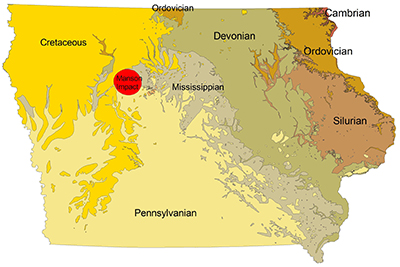Meteor from 74 million years ago still affects Iowa water

Although the lab is regularly called upon to perform well water testing, the area where the incident occurred made the case unusual, said Terry Cain, environmental lab supervisor.
Calhoun County, in west-central Iowa, includes much of the Manson Impact Area, where the meteorite crashed into the Earth. The 12-trillion ton mass struck what is now Manson, Iowa, causing widespread devastation, said to have more than the combined forces of all of the world's nuclear explosives.
All life was destroyed in a circle with a 650-mile radius, extending from what is now Denver to Detroit and Winnipeg, Canada, to Dallas. The meteorite formed a crater that remains buried under the landscape, stretching 24 miles wide through four counties – Calhoun, Pocahontas, Humboldt and Webster.
It's that crater that still affects the water supply in the area.
Julie Sievers, senior environmental specialist for the Iowa Department of Natural Resources (IDNR), said it is not uncommon for owners of private wells in the area to purchase water from the city or other entities.
Because of the aquifer and geologic formations, "there is limited and unpredictable water availability in that area," she said. "If there is a large use of water, it's not unusual for the owner to purchase water and haul it to put into their well."
That practice should be used with caution, Sievers added, citing the tank itself, as well as hoses that could expose the water to contaminants. "It introduces inherent risks."
Renters of a house in the county contacted Calhoun County Environmental Health Sanitarian Shelly Schossow with questions about their drinking water. Family members reported numbness and tingling in their mouths after drinking the water from a shallow, 80-year-old private well.
Water had been injected into this well from another well located across the street. Decades before, the second well was compromised when fuel leaked into it, causing concern that the water may catch fire, posing a public health threat as well as the health concerns by the family.
The State Hygienic Laboratory, Iowa Department of Natural Resources and Iowa Department of Public Health were called in to assist the county.
Contaminants in water can lead to health issues, including gastrointestinal illness, reproductive problems and neurological disorders, according to the CDC. Infants, young children, pregnant women, the elderly and people whose immune systems are compromised because of AIDS, chemotherapy or transplant medications may be especially susceptible to illness from contaminants.
The CDC notes that sources of drinking water can become contaminated through naturally occurring chemicals and minerals, such as arsenic and radon; local land use practices from pesticides, chemicals and animal feeding operations; malfunctioning wastewater treatment systems; and other sources.
Cain said the lab conducted three tests: one for volatile petroleum hydrocarbons and one for total extractable hydrocarbons, both related to possible petroleum contaminants, such as benzene, and also a test for pesticides using mass spectrometry, to detect other chemicals.
The petroleum tests were advised after a report of a possible leaking underground storage tank near the home. The laboratory also tested for levels of pesticides using the broadest agri-chemical scan we can do," Cain said.
A team from the Hygienic Laboratory’s Environmental Health Division quickly responded to the multi-agency effort. The analytical staff of Nick Baumhover, Peter Ma, Lisa Limkemann and Mark Scaffinger worked with other members of lab staff – Nancy Hall, Josh Mara, Mike Schueller and Cain – to provide testing results within just two days.
Results indicated low-level pesticide contamination, Cain said, by "products that are really not that unusual in Iowa," and likely would not cause adverse health effects.
The Hygienic Lab team in partnership with the other agencies brought this case to a quick resolution.
"This was a good example of a collaboration of several different agencies and entities to make sure we understood what was going on," said Sievers from IDNR.
Sievers recommends that Iowans who need to inject their wells with water from outside sources use equipment dedicated for drinking water, good disinfection practices and routine testing.
In any case, to assure safety, water from private wells should be checked every year or any time the water quality changes, for mechanical problems, cleanliness, and the presence of coliform bacteria, nitrates and any other contaminants of local concern.
The Iowa Grants to Counties Program assists private well owners obtain testing. Grants are made available to local county health departments to provide free water testing to Iowa residents whose primary source of drinking water comes from private wells. Residents who live in a county that participates in the program can have their private well water tested for total coliform bacteria and nitrates at no cost.
Contact your county health department to find out if it participates in the Grants to Counties program. If your county doesn’t participate in the program, Iowans can contact the State Hygienic Laboratory directly to have water tested for a fee.
Iowans with health concerns that could be related to their drinking water should consult their doctor, then contact their county sanitarian at the county health department, Cain from the Hygienic Lab advised. The county health department could then reach out to the State Hygienic Lab if needed.



